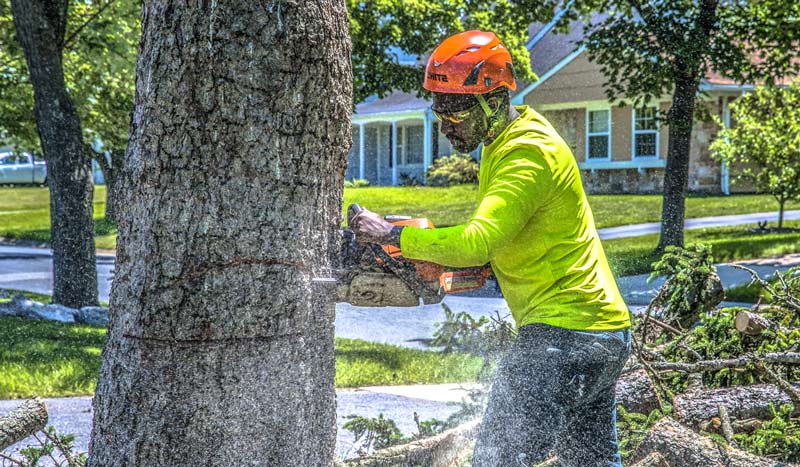If you’ve decided to remove a tree, you’ll need to plan carefully. Consider whether it will affect your plants, including the ones that love the shade of a tree. You may want to plant new shade trees in the area to prevent the loss of these flowers. You also may want to store the chopped-down tree for firewood. In addition, you might want to consider hiring certified arborists to help you.
Identifying an escape route
When cutting down a tree, it is important to identify an escape route. You can start cutting on the outside of the tree first to ensure there is no tension on the branches. Then, work your way towards the trunk of the tree. This will help ensure that the tree does not fall over.
It is important to have an escape path set up in case the tree falls on you. This should be at least 15 feet long and at an angle of about 45 degrees from the direction in which it fell. This way, you will not be backed into the falling tree.
When cutting down a tree, you should always consider the direction the tree is going to fall. It is best to place the tree at a 45-degree angle so that it does not lean in one direction. Also, make sure that you have someone holding the saw and that there are no other obstacles in your way. Also, be sure to mark the area with warning signs, such as hazard tape. Make sure you warn the passersby to stay away from the falling tree.
Preventing damage to branches, trunks, and roots
When cutting down a tree, you should take special care to avoid wounding the trunk or branches. Tree wounds can be caused by animals such as rabbits, squirrels, and field mice that feed on the new bark of trees during winter. To keep these animals from feeding on the new growth, place a fence or plastic tree guard around the tree. It is also advisable to inspect the wounds periodically.
In addition to cutting the tree, it is advisable to cut off as much of the root system as possible. According to Johnson, a tree’s roots can be up to 40 percent of its volume. Cutting down the roots reduces the tree’s water and nutrient uptake, and can compromise its stability. If you’re planning to dig under the tree’s roots, you should start at least three to six inches beneath the surface. This will ensure that you contact the fill soil better and avoid a sharp line.
Branches and trunks are most vulnerable to damage after a storm, and you should protect them. In severe weather, the wind may blow a branch off and cause the tree to topple over. In addition, limbs can be struck by trucks or large equipment, causing significant damage to the tree.

Storing chopped-down trees as firewood
There are several ways to use chopped-down trees for firewood. Some can be used directly as firewood while others require professional removal. Oftentimes, trees can be salvaged if they have a good portion of the trunk still intact. While storing chopped-down trees for firewood is an easy way to recycle these unwanted wood products, it is best to seek professional tree removal for these large trees. The team at https://www.treeremovalsalinas.com/ can be of the best help for your tree removal project.
Storing chopped-down trees as firewood is one way to recycle wood and avoid landfills. Ideally, firewood is stored for at least four years. Older wood is preferable to green wood. Also, wood that is aerated helps it burn more efficiently and prevents dampness. Avoid burning wood that is soft or rotten. Such wood contains a lot of moisture and may contain bacteria.
Before cutting down trees, make sure you consult with the landowner. You need to let them know which trees you would like to cut, and how to access the wood. It is also necessary to agree on what to do with the leftover wood and debris. Some landowners may require a small payment in exchange for the wood. Others may ask you to sign a contract stating that you will not sue them.
Hiring certified arborists
Hiring a qualified arborist after cutting a tree is a great way to minimize the risk of injury. Not only does this professional have the training and equipment to safely perform specialized tree work, but they are also required to carry workers’ compensation and liability insurance. It is also important to ask for references and get several estimates before making a decision. Avoid door-to-door bargains, and always ensure that the arborist you hire has the experience and is bonded. You may also want to look for certifications and memberships in professional associations, which distinguishes reputable companies from fly-by-night companies.
Certified arborists are trained professionals who have been through rigorous training and certification. They are certified by the International Society of Arboriculture (ISA) and the Tree Care Industry Association (TCIA). Certified arborists are equipped with a high level of training and know how to properly identify and solve tree problems. They have extensive training in tree health and disease diagnosis, as well as pest identification. Additionally, you should look for proof of worker’s compensation and liability insurance, and a contract stipulating what services will be performed. While not all tree care companies hire certified arborists, it is best to hire a company that has one or more of these experts on staff.
